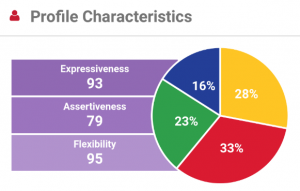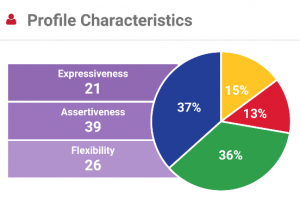
In the workplace and in our personal relationships, it’s likely that we’ve all experienced the intent-impact gap. Simply put, the intent-impact gap is what occurs when our words or actions are misinterpreted by another individual.
Consider this story: Sara, the Director of Learning and Development, and her direct report Chris, the Program Manager, are assessing their list of priority projects and need to decide whether to focus on restructuring their onboarding program or re-evaluating their Learning Management System (LMS). Together, they decide to re-evaluate their LMS and each team member takes away their marching orders.
The following week – after Chris has made significant progress on his responsibilities – Sara comes back after conversations with other departments and reports that onboarding will be the priority going forward.
Immediately, Chris’s demeanor changes. He begins asking lots of questions about what caused the change, why should onboarding be their top priority and if this decision is going to change again.
After this exchange, Sara starts to question Chris’s attitude. Chris, meanwhile, is wondering if Sara can stick to her commitments.
This is a perfect example of the intent-impact gap.
In this scenario, Sara intends to pick a project that will have the most positive impact on the company, and after further conversations with other departments, she recognizes that onboarding is the right project. Sara didn’t intend for her direct report to interpret this change as wishy-washy, nor did she expect this change to negatively impact Chris.
Conversely, Chris is not trying to be difficult. His intention is to understand why this change occurred, yet his line of questioning has a different impact on his manager, who begins to doubt his intentions.
The results of the intent-impact gap can be severe. It may start with an employee simply rolling their eyes. Tensions can escalate quickly, though. When employees misperceive their colleagues’ intent, this can lead to unproductive conflict and distrust.
I think we all intuitively know why trust matters. To emphasize the point, Harvard Business Review published a study of hotel staff that showed when employees trusted their managers, the hotels were significantly more profitable. Improving a hotel’s trust score by one-eighth of a point increased profitability by 2.5 percent.
Building trust is clearly important to building a successful organization, and so to encourage a more trusting environment, it’s important to take steps to reduce the intent-impact gap. Here are three tips that you and your organization can use:
1. Remove judgment
When you are in a disagreement, it’s hard to take emotion out of the equation. And still, you need to find a way to do it. Remember that decisions at work are rarely personal, so remove judgment and focus on the situation itself.
Let’s consider if we took judgment out of the situation between Sara, the Director of Learning and Development, and Chris, the Program Manager.
If Sara removed her judgment that Chris isn’t a team player, she might realize that he is just trying to understand why the change happened.
If Chris removed his judgment that his boss can’t keep commitments, he might recognize that there is likely a reason behind this new direction and calmly ask why.
2. Understand yourself
Self-awareness can help close the intent-impact gap. When you understand yourself, you are more likely to recognize your strengths and blind spots.
One of the most useful ways to gain self-awareness is by using an assessment like the Emergenetics® Profile.
In the situation of imposed change between Chris and Sara, what might have happened if they had a tool like Emergenetics?
Sara’s Profile Chris’s Profile


Looking at Sara’s Profile, we might have discovered that Sara’s Flexibility is what we call third-third, meaning she welcomes change and is open to new directions even after a choice has been made.
Meanwhile, Chris has a preference in first-third Flexibility, meaning that he prefers to stay focused and firm. He will gain energy from driving an original decision forward.
If Sara and Chris had this self-awareness of their feelings toward change, they may have approached the situation differently. For example, Sara may have recognized that her third-third Flexibility can be hard for others to immediately accept, so she may have provided more context for her decision up front.
Meanwhile, Chris might have realized that he prefers to stay firm from his first-third Flexibility preference and recognize that priorities do change.
3. Consider how you can flex and build skill
When you are delivering information, consider how others may want to receive it – not just how you would want to hear it. One way to get this information is to ask your team members what they need to know to get on board with a decision or what questions typically come to mind when they are receiving direction.
Tools like the Emergenetics Profile can also help you understand others’ preferences. Let’s consider Sara and Chris again. If Sara knew that Chris had a preference for first-third Flexibility (or used the Emergenetics+ app to look at his preferences prior to their meeting), she may have started with the “why” behind changing the team’s direction and allowed for him to digest the change before asking that he jump on board.
Moreover, Sara may have looked to Chris’s thinking preferences as well. In seeing that Chris has a preference in Analytical and Structural thinking, Sara could have tailored her discussion to speak to the data behind why focusing on onboarding is more important at present than their LMS system and provided some ideas about how to switch course. By communicating through the preferences of team members, this conflict may have been avoided altogether.
While intent-impact gaps may be common in organizations, they don’t have to be an issue in yours. Set the example and encourage programming to lessen this gap by removing judgment, using assessments to build self-awareness and modeling how to flex to support the needs of others. With these three steps, your company will set the stage for better communication and trust.
Do you have questions about how to address communication challenges in your organization? Fill out the form below to speak with one of our experts!
 Print This Post
Print This Post
